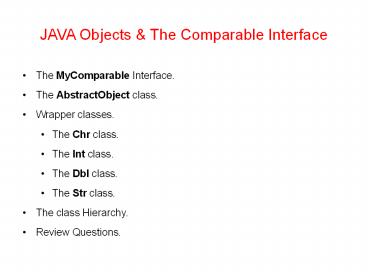JAVA Objects PowerPoint PPT Presentation
Title: JAVA Objects
1
JAVA Objects The Comparable Interface
- The MyComparable Interface.
- The AbstractObject class.
- Wrapper classes.
- The Chr class.
- The Int class.
- The Dbl class.
- The Str class.
- The class Hierarchy.
- Review Questions.
2
The MyComparable Interface
- Being able to compare objects is very important
in the study of data structures. - Java has a comparable interface but it is very
limited - it only has the compareTo method. - Thus, we introduce our comparable interface as
follows and most of the data structure classes
we shall develope in this course will implement
this interface. - 1 public interface MyComparable
- 2 boolean isLT (MyComparable object)
- 3 boolean isLE (MyComparable object)
- 4 boolean isGT (MyComparable object)
- 5 boolean isGE (MyComparable object)
- 6 boolean isEQ (MyComparable object)
- 7 boolean isNE (MyComparable object)
- 8 int compare (MyComparable object)
- 9
3
The AbstractObject class
- All Java classes are derived from the base class
Object. - The Object class has the equals method that
allows objects to be tested for equality, but we
need to be able to do more than just test for
equality. - Thus, we define our own base class that
implements our comparable interface. - 1 public abstract class AbstractObject implements
MyComparable - 2
- 3 public final boolean isLT (MyComparable
object) - 4 return compare (object) lt 0
- 5
- 6 public final boolean isLE (MyComparable
object) - 7 return compare (object) lt 0
- 8
- 9 public final boolean isGT (MyComparable
object) - return compare (object) gt 0
- 11 public final boolean isEQ (MyComparable
object) - 12 return compare (object) 0
- 13
- 14 public final boolean isNE (MyComparable
object) - 15 return compare (object) ! 0
4
The AbstractObject class (contd.)
- 16
- 17 public final boolean equals (Object
object) - 18 if (object instanceof MyComparable)
- 19 return isEQ ((MyComparable)
object) - 20 else
- 21 return false
- 22
- 23
- 24 public final int compare (MyComparable
arg) - 25 if (getClass () arg.getClass ())
- 26 return compareTo (arg)
- 27 else
- 28 return getClass ().getName
().compareTo ( - 29 arg.getClass ().getName ())
- 30
- 31 protected abstract int compareTo
(MyComparable arg) - 32
5
Wrapper classes
- Just as we could not rely on Java's Object class,
we also - cannot rely on Java's wrapper classes - not
MyComparable. - Moreover, all the wrapper classes were defined as
final, thus, we cannot extend them to make them
MyComparable. - Therefore, we have to define our own wrapper
classes. - 1 public class Chr extends AbstractObject
- 2 protected char value
- 3
- 4 public Chr (char value)
- 5 this.value value
- 6
- 7 public char charValue ()
- 8 return value
- 9
- 10 protected int compareTo (MyComparable
object) - 11 Chr arg (Chr) object
- 12 return (int) value - (int) arg.value
- 13
- 14
6
Wrapper classes (contd.)
- 1 public class Int extends AbstractObject
- 2 protected int value
- 3
- 4 public Int (int value)
- 5 this.value value
- 6
- 7 public int intValue ()
- 8 return value
- 9
- 10 protected int compareTo (MyComparable
object) - 11 Int arg (Int) object
- 12 if (value lt arg.value)
- 13 return -1
- 14 else if (value gt arg.value)
- 15 return 1
- 16 else
- 17 return 0
- 18
- 19
7
Wrapper classes (contd.)
- 1 public class Dbl extends AbstractObject
- 2 protected double value
- 3
- 4 public Dbl (double value)
- 5 this.value value
- 6
- 7 public double doubleValue ()
- 8 return value
- 9
- 10 protected int compareTo (MyComparable
object) - 11 Dbl arg (Dbl) object
- 12 if (value lt arg.value)
- 13 return -1
- 14 else if (value gt arg.value)
- 15 return 1
- 16 else
- 17 return 0
- 18
- 19
8
Wrapper classes (contd.)
- 1 public class Str extends AbstractObject
- 2 protected String value
- 3
- 4 public Str (String value)
- 5 this.value value
- 6
- 7 public String stringValue ()
- 8 return value
- 9
- 10 protected int compareTo (MyComparable
object) - 11 Str arg (Str) object
- 12 return value.compareTo (arg.value)
- 13
- Implementation of the rest of the wrapper classes
are left - as exercises.
9
Summary
- We have introduced MyComparable interface, the
AbstractObject class and our wrapper classes. - The class hierarchy so far is as shown in the
figure below. - The conventions used in drawing the tree are
rounded rectangle is for interfaces filled
rectangle for abstract classes and unfilled
rectangle is used for concrete classes. - Dotted lines are for implements and solid lines
for extends.
Chr
MyComparable
AbstractObject
Int
Dbl
Str
10
Review Questions
- Suppose we define two concrete classes A and B,
both of which are derived from the AbstractObject
class. Furthermore, let a and b be instances of
classes A and B respectively, declared as
follows - 1 public class A extends AbstractObject ...
- 2 public class B extends AbstractObject ...
- 3 Comparable a new A()
- 4 Comparable b new B()

